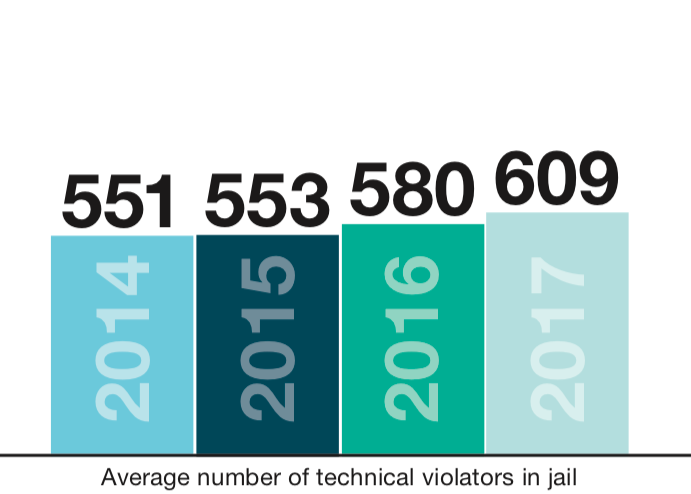
MOCJ
According to the Mayor's Office of Criminal Justice, parole technical violators make up 6.6 percent of the average daily population in city jails.
As New York embarks on the closure of Rikers Island, the city and state have focused on ways to reduce the population inside of our city jails. Bail reform, speedy trials, and supervised release are among the programs that will promise to reduce the daily census inside Rikers Island and the new borough-based facilities.
Yet, one population is steadily increasing at a time when all others are being reduced: parole violators. This year, New York State should build on its progressive criminal justice record and reform the state parole system.
Established in the 19th century, parole was explicitly designed to keep people out of detention. But with over 600 people held on technical parole violations at Rikers every day, it is time we recognize that the system is not working.
Parole is run by the state, and it disproportionately impacts our city jails. Technical parole violators are the only population in New York City jails on the rise. According to the New York Times, from 2014 to 2018, the percentage of people held on technical violations of parole increased by 15 percent, despite the overall jail population decreasing by 21 percent. Almost 20 percent of those jailed on Rikers Island are there for parole violations.
These individuals have already served their time for a crime committed. Now, these individuals are being detained for a technical parole violation: a non-criminal offense such as staying out past curfew, missing an appointment, or failing a urine test. Under our current system, technical parole violators return to city jails, where they wait as long as three months to see an administrative law judge who will decide whether to release them or send them back to jail. With the city’s eye on decarceration and alternatives to incarceration, it is critical to reduce the number of people held on technicalities in our jails. Actions taken by judges and parole officers can prove consequential and stray from its greater intention of reintegration in society, as well.
As we work to reform the criminal justice system, all aspects must be overhauled, including how it is systematically designed to target certain groups. The Columbia University Justice Lab found that New Yorkers on parole are also more likely to be reincarcerated for violating their conditions of parole, rather than committing a new offense.
Get the best of City Limits news in your inbox.
Select any of our free weekly newsletters and stay informed on the latest policy-focused, independent news.
There is legislative hope. The Less is More Act, sponsored by Senator Brian Benjamin and Assemblyman Walter Mosley, returns parole back to its original state: a supervision model designed to keep individuals in their community. The Act reforms the parole system by eliminating incarceration as a sanction for certain technical violations and mandating alternatives.
My resolution, Reso. 829, due this week, calls on the state to bring us all closer to these more just practices. With nearly 35,000 New Yorkers on parole, we can responsibly reduce the number of people incarcerated for technical violations and continue to lower our jail population.
There is a great opportunity in front of New York to decrease the city jail population in a meaningful way without raising any public safety concerns. 2019 is the year to do it.
Councilmember Keith Powers represents New York City’s District 4, covering the East Side of Manhattan and Midtown, and serves as Chair of the Council’s Criminal Justice Committee.







